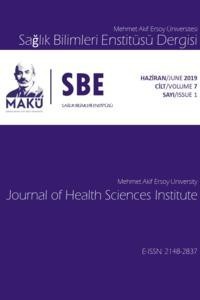Assessing the susceptibility of some gut bacteria to the extract from needles of Turkish pine
Assessing the susceptibility of some gut bacteria to the extract from needles of Turkish pine
Antibacterial, Gut bacteria, MIC, Plant extracts Turkish pine needle,
___
- Ahn, Y.J., Lee, C.O., Kweon, J.H., Ahn, J.W., Park, J.H., 1998. Growth‐inhibitory effects of Galla Rhois‐derived tannins on intestinal bacteria. Journal of Applied Microbiology 84(3), 439-443.
- Balaban Ucar, M., Ucar, G., Pizzi, A., Gonultas, O., 2013. Characterization of Pinus brutia bark tannin by MALDI-TOF MS and 13C NMR. Industrial Crops and Products 49, 697-704.
- Bäumler, A.J., Sperandio, V., 2016. Interactions between the microbiota and pathogenic bacteria in the gut. Nature 535(7610), 85-93.
- Canny G.O., McCormick B.A., 2008. Bacteria in the intestine, helpful residents or enemies from within? Infection and Immunity 76, 3360-3373.
- CLSI (Clinical and Laboratory Standards Institute), 2016. M100-S26, Performance standards for antimicrobial susceptibility testing. 26th Informational Supplement, Wayne, PA, CLSI.
- Das, A., Datta, S., Mukherjee, S., Bose, S., Ghosh, S., Dhar, P., 2015. Evaluation of antioxidative, antibacterial and probiotic growth stimulatory activities of Sesamum indicum honey containing phenolic compounds and lignans. LWT - Food Science and Technology 61, 244-250.
- Demirtaş, A., 2020. Influence of Pinus brutia bark extract containing phenolic compounds on some commensal and pathogenic bacteria from the intestinal microflora. Mehmet Akif Ersoy Üniversitesi Veteriner Fakültesi Dergisi 5(2), 34-39.
- Demirtas, A., Ozturk, H., Sudagidan, M., Keyvan, E., Yavuz, O., Yıldız-Gulay, Y., Musa, S.A.A., (2019). Effects of commercial aldehydes from green leaf volatiles (green odour) on rumen microbial population and fermentation profile in an artificial rumen (Rusitec). Anaerobe 55, 83-92.
- Goker, G., Demirtas, A., 2020. Preliminary study on stimulatory and inhibitory effects of aldehydes from the green leaf volatiles family on beneficial and pathogenic bacteria from the intestine. Medycyna Weterynaryjna 76(3), 170-175.
- Hmamouchi, M., Hamamouchi, J., Zouhdi, M., Bessiere, J.M., 2001. Chemical and antimicrobial properties of essential oils of five Moroccan Pinaceae. Journal of Essential Oil Research 13(4), 298-302.
- Hobson, P.N., 1969. Rumen Bacteria. In: Methods in Microbiology. London and New York, Academic Press, pp. 133-149.
- Hwang, Y.H., Lee, H.S., 2002. Antibacterial activity of Pinus densiflora leaf-derived components toward human intestinal bacteria. Journal of Microbiology and Biotechnology 12(4), 610-616.
- Kaundun, S.S., Fady, B., Lebreton, P., 1997. Genetic differences between Pinus halepensis, Pinus brutia and Pinus eldarica based on needle flavonoids. Biochemical Systematics and Ecology 25(6), 553-562.
- Keeratirathawat, S., Nair, J., Levitan, J., 2013. The antibacterial efficacy of pine oils on pathogens commonly found in biosolids applied to pine plantations. International Journal of Environment and Waste Management 12(2), 146-153.
- Ko, H.H, Lareu, R.R., Dix, B.R., Hughes, J.D., 2018. In vitro antibacterial effects of statins against bacterial pathogens causing skin infections. European Journal of Clinical Microbiology 37, 1125-1135.
- Ørskov F, Ørskov I., 1992. Escherichia coli serotyping and disease in man and animals. Canadian Journal of Microbiology 38(7), 699-704.
- Patra A.K., Stiverson J., Yu Z., 2012. Effects of quillaja and yucca saponins on communities and select populations of rumen bacteria and archaea, and fermentation in vitro. Journal of Applied Microbiology 113, 1329-1340.
- Rajkovic A., 2014. Microbial toxins and low level of foodborne exposure. Trends in Food Science & Technology 38(2), 149-57.
- Shang, F.M., Liu, H.L., 2018. Fusobacterium nucleatum and colorectal cancer: A review. World Journal of Gastrointestinal Oncology 10(3), 71-81.
- Üner, B., Karaman, İ., Tanrıverdi, H., Özdemir, D., 2011. Determination of lignin and extractive content of Turkish Pine (Pinus brutia Ten.) trees using near infrared spectroscopy and multivariate calibration. Wood Science and Technology 45(1), 121-134.
- Yener, H.O., Saygideger, S.D., Sarikurkcu, C. Yumrutas, O., 2014. Evaluation of antioxidant activities of essential oils and methanol extracts of pinus species. Journal of Essential Oil Bearing Plants 17(2), 295-302.
- Zeng, W.C., He, Q., Sun, Q., Zhong, K., Gao, H., 2012. Antibacterial activity of water-soluble extract from pine needles of Cedrus deodara. International Journal of Food Microbiology 153(1-2), 78-84.
- ISSN: 2148-2837
- Yayın Aralığı: Yılda 3 Sayı
- Başlangıç: 2013
- Yayıncı: Burdur Mehmet Akif Ersoy Üniversitesi
Effect of synthetic cannabinoids (JWH-018) on antibody response to HBV vaccination
Assessing the susceptibility of some gut bacteria to the extract from needles of Turkish pine
Physical activity level during COVID-19 global pandemic and its relation to well-being
Murat TOMRUK, Melda SOYSAL TOMRUK, İsmail ÇALIK
Nurses’ Knowledge Level about High-Alert Medications
